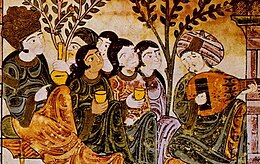Muwashshah
| Part of a series on |
| Arabic culture |
|---|
 |
Muwashshah (Arabic: موشح muwaššaḥ literally means "girdled" in Classical Arabic; plural muwaššaḥāt موشحات or tawāšīḥ تواشيح) is the name for both an Arabic poetic form and a secular musical genre. The poetic form consists of a multi-lined strophic verse poem written in classical Arabic, usually consisting of five stanzas, alternating with a refrain with a running rhyme. It was customary to open with one or two lines which matched the second part of the poem in rhyme and meter; in North Africa poets ignore the strict rules of Arabic meter while the poets in the East follow them. The musical genre of the same name uses muwaššaḥ texts as lyrics, still in classical Arabic.[1] This tradition can take two forms: the waṣla of Aleppo and the Andalusi nubah of the western part of the Arab world.
History[]
While the qasida and the maqama were adapted from the Mashreq, strophic poetry is the only form of Andalusi literature known to have its origins in the Iberian Peninsula.[2] Andalusi strophic poetry exists in two forms: the muwaššaḥ: a more complex version in Standard Arabic with the exception of the concluding couplet, or the kharja, and zajal: a simpler form entirely in vernacular Arabic.[2] The earliest known muwaššaḥs date back to the eleventh century.[2]
It was exported to the east, and celebrated there by figures such as and Ibn Dihya.[2] The corpus of muwaššaḥs is formed by pieces in Hebrew and in Arabic.[2] Tova Rosen describes the muwaššaḥ as "a product and a microcosm of the cultural conditions particular to al-Andalus.[2] The linguistic interplay between the standard written languages—Arabic and Hebrew—and the oral forms—Andalusi vernacular Arabic, Romance, and Mozarabic—reflect the fluidity and diversity of the linguistic landscape of al-Andalus.[2]
The poetic form[]
Examples of muwaššaḥ poetry start to appear as early as the 9th or 10th century. It is believed to come from the Arabic roots wšaḥ (وشح) which means any thing that a woman might wear on her neck from a necklace to a scarf, and the verb Tawašḥ means to wear.[3][4] Some relate it to the word for a type of double-banded ornamental belt, the wišaḥ, which also means a scarf in Arabic.[3] The underlying idea is that, as there is a single rhyme running through the refrain of each stanza, the stanzas are like objects hung from a belt.
The musical genre[]
Musically, the ensemble consists of oud (lute), kamanja (spike fiddle), qanun (box zither), darabukkah (goblet drum), and daf (tambourine): the players of these instruments often double as a choir. The soloist performs only a few chosen lines of the selected text. In Aleppo multiple maqam rows (scales) and up to three awzān (rhythms) are used and modulation to neighboring maqamat was possible during the B section[clarification needed]. Until modernization it was typical to present a complete waslah, or up to eight successive muwaššaḥ including an instrumental introduction (sama'i or bashraf).[5] It may end with a longa. Famous Muwashshah songs still played in the Arab World today include Lamma Bada Yatathanna and Jadaka al-Ghaithu.
Famous poets[]
- Al-Tutili
- Avempace
- Avenzoar
- Ibn al-Khatib
- Ibn Baqi
- Ibn Zamrak
See also[]
- Aljamiado
- The kharja is the final stanza of a muwaššaḥ, of which a few are in the Mozarabic language and therefore the first attesting of an Iberian Romance language and first written examples of the Castilian language.
- Zajal
- Fasıl
- Malouf
- Emilio García Gómez
- James T. Monroe
References[]
- Citations
- ^ Touma 1996, p. 71.
- ^ Jump up to: a b c d e f g Rosen, Tova (2000-08-31), "The muwashshah", The Literature of Al-Andalus, Cambridge University Press, pp. 163–189, ISBN 978-0-521-47159-6, retrieved 2021-06-16
- ^ Jump up to: a b Lane, Edward (1893). An Arabic-English Lexicon: Derived From the Best and the Most Copious Eastern Sources. Williams and Norgate. p. 2943.
- ^ Manzur, Ibn. Lisan Al-Arab. 2. p. 632.
- ^ Touma 1996, p. 83.
- Bibliography
- Benbabaali, Saadane, 1987, Poétique du muwashshah dans l'Occident musulman médiéval, thèse de 3e cycle, sous la direction de R. Arié, Paris 3, 1987.
- Benbabaali, Saadane "La plume, la voix et le plectre, avec Beihdja Rahal, Barzakh, Alger, Déc. 2008.
- Benbabaali, Saadane Bahdjat al-Nufûs fî Bahâ'i Djannât al-Andalus (l'Amour, la femme et les jardins dans la poésie andalouse) ANEP, Alger,2010
- Corriente, Federico (1997). Poesía dialectal árabe y romance en Alandalús: cejeles y xarajat de muwassahat. Madrid: Gredos. ISBN 84-249-1887-8.
- Emery, Ed (2006). Muwashshah: proceedings of the Conference on Arabic and Hebrew Strophic Poetry and its Romance Parallels, School of Oriental and African Studies (SOAS), London, 8–10 October 2004. London: RN Books.
- Jones, Alan (1987). Romance Kharjas in Andalusian Arabic Muwassah poetry: a palaeographic analysis. London: Ithaca. ISBN 0-86372-085-4.
- Jones, Alan & Hitchcock, Richard (1991). Studies on the Muwassah and the Kharja: proceedings of the Exeter international colloquium. Reading: Published by Ithaca for the Board of the Faculty of Oriental Studies, Oxford University. ISBN 0-86372-150-8.
- Touma, Habib Hassan (1996). The Music of the Arabs, trans. Laurie Schwartz. Portland, Oregon: Amadeus Press. ISBN 0-931340-88-8.
- Zwartjes, Otto (1997). Love songs from al-Andalus: history, structure, and meaning of the kharja. Leiden: Brill. ISBN 90-04-10694-4.
- Zwartjes, Otto & Heijkoop, Henk (2004). Muwassah, zajal, kharja: bibliography of eleven centuries of strophic poetry and music from al-Andalus and their influence on East and West. Leiden-Boston: Brill. ISBN 90-04-13822-6.
- Arabic literature
- Arab culture
- Arabic music
- Arabic poetry forms
- Classical and art music traditions
- Culture of Al-Andalus
- Literary genres
- Poetic form
- Song forms
- Syrian music
- Vocal music
- Jewish literature
- Islamic literature